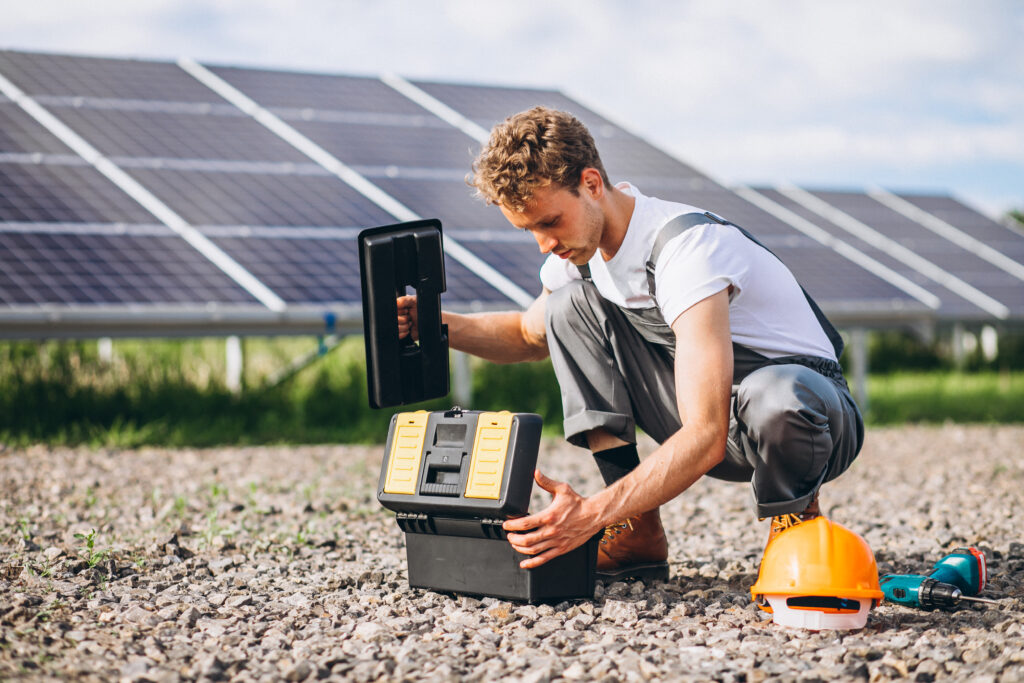
Man worker in the firld by the solar panels
Switching to solar is one of the smartest decisions homeowners and businesses can make today. But before a single panel goes on your roof, there’s a crucial step that determines how well your system will perform: solar panel system design.
A good design isn’t just about putting panels in a sunny spot. It’s about planning every detail – from energy needs to roof space, from wiring to inverters – so your system runs safely and delivers maximum savings. In this guide, we’ll walk through the step-by-step process and explain how a solar panel designer or solar panel design consultant makes sure your system works at its best.
Step 1: Assess Your Energy Needs
The first step in solar panel system design is figuring out how much electricity you use. Your past 6–12 months of utility bills can show your average monthly and seasonal energy demand.
- A small home may only need a 5 kW system.
- A larger household with electric heating or EV charging may need 10 kW or more.
Getting this right helps ensure you don’t end up with a system that’s too small (causing high bills) or too big (extra cost you don’t need).
Step 2: Evaluate the Site
Not every roof is the same, and location matters. A solar panel design consultant usually checks:
- Roof orientation and tilt – South-facing roofs get the most sun in the U.S.
- Shade – Trees, chimneys, or nearby buildings can cut down production.
- Roof condition – Solar panels last 20–25 years, so the roof should be in good shape.
If a roof isn’t ideal, ground-mounted systems can be considered.
Step 3: Choose the Right Solar Panels and Inverter
Next comes equipment selection. A solar panel designer helps match your needs with the right technology:
- Panels: Options range from standard to high-efficiency panels.
- Inverters: String inverters are cheaper but can be less efficient if shade is an issue, while microinverters maximize production per panel.
Your system’s efficiency depends heavily on these choices.
Step 4: System Layout and Electrical Design
Now it’s time to map out how everything fits together. In this stage of solar panel system design, the layout includes:
- Panel placement on the roof (maximizing sunlight)
- Wiring routes for safety and efficiency
- Connection points to the main service panel
This step ensures your system isn’t just powerful but also safe and code-compliant.
Step 5: Storage and Backup (Optional but Smart)
While not required, adding batteries can increase your system’s value. A solar panel design consultant can help decide if battery storage makes sense for you:
- Without batteries: Solar powers your home during the day, and you use grid power at night.
- With batteries: Extra energy is stored for nighttime or during blackouts.
In states like Texas and California, battery systems are becoming more popular due to grid outages.
Step 6: Permits and Approvals
Before installation, permits must be filed with the city or county. Your solar panel designer ensures all plans meet building and electrical codes. Utility companies also review the design for safe grid connection.
This step may feel slow, but it’s critical to avoid legal or safety issues later.
Step 7: Installation and Inspection
Once the design is approved, installation can begin. Afterward, inspectors check the system to confirm it matches the approved design and is safe to operate.
This is where you see all the planning come to life – your roof turns into a mini power plant.
Step 8: Monitoring and Maintenance
The final step is ongoing performance monitoring. Modern systems include apps or dashboards that let you see how much power your panels generate daily.
A good solar panel system design makes monitoring easy, so you always know your system is working at peak efficiency.
Why Work with a Solar Panel Design Consultant?
Designing a solar system involves math, electrical codes, and safety standards. A professional consultant:
- Analyzes your home’s energy needs
- Optimizes placement for maximum sun exposure
- Chooses the right equipment for your budget
- Handles paperwork and permits
While DIY design is possible, mistakes can be costly. That’s why most homeowners rely on a solar panel designer to ensure accuracy and long-term savings.
Final Thoughts
The success of your solar journey starts with the right solar panel system design. By following these steps – from energy assessment to monitoring – you ensure that your system runs efficiently, saves money, and lasts for decades.
Working with a solar panel design consultant makes the process smoother, while a skilled solar panel designer guarantees that every detail is handled correctly.
Solar energy isn’t just about panels on your roof – it’s about a smart design that brings sunshine into real savings.

